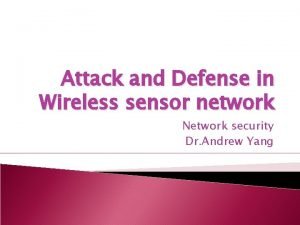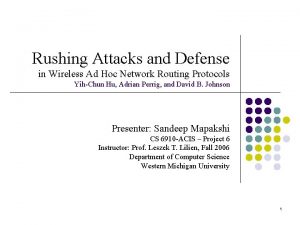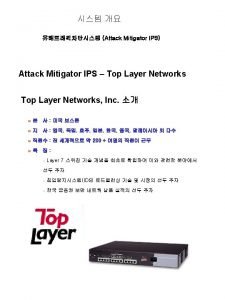Developing Attack Defense Ideas for Ad Hoc Wireless





























![References [9] P. Angin, B. Bhargava, R. Ranchal, N. Singh, L. Lilien, L. Othmane References [9] P. Angin, B. Bhargava, R. Ranchal, N. Singh, L. Lilien, L. Othmane](https://slidetodoc.com/presentation_image_h2/4364746633caf9f47d1957aadd9ef7d7/image-30.jpg)
- Slides: 30

Developing Attack Defense Ideas for Ad Hoc Wireless Networks Bharat Bhargava Computer Science Department/CERIAS, Purdue University, West Lafayette, IN, USA bbshail@purdue. edu 765 -413 -7312

Outline 1. 2. 3. 4. 5. Motivation Objectives Attacks Impact of Attacks on Safety Impact of Implementing Security Features 5. 1 Case of Study: Security vs. Safety 6. References 2

Motivation Vehicle has more than 60 sensors and 30 or more Electronic Control Units (ECUs), i. e. Brake Control, Engine Control, GPS, Airbag Control, etc [6] CAN (Control Area Network) Bus 3 Radio Interface or On-Board Unit (OBU) enables short-range wireless ad hoc networks to be formed OBU allows heterogeneous and homogenous communications between vehicles and infrastructures (roadside equipment)

Motivation Connected vehicles deploy signals to communicate with other vehicles, roadside units, personal devices and cloud services • Goal: provide assistance to drivers and prevent collisions Connected vehicle consists of electronic control units (ECUs) communicating via CAN (Controller Area Network) bus to transfer messages and execute queries sent from other ECUs Vehicle-to-vehicle (V 2 V) and vehicle-to-infrastructure (V 2 I) communications are prone to security threats 4

Objectives 1. Measure the cost/overhead associated with providing security in V 2 V communication and its impact on safety 2. Monitor, Identify, and Mitigate Attacks 5

Attacks in Ad Hoc Wireless Networks Distributed Denial-of-service Attacks Spoofing Attacks Replay Attacks Worm hole Attacks Eavesdropping Interception Masquerade Attack Malware Attack Message Tampering Collaboartive Attacks

Details of Attacks • Replication attacks • Adversaries can insert additional replicated hostile nodes into the network after obtaining some secret information from the captured nodes or by infiltration. Sybil attack is one form of replicated attacks • Sybil attacks • A malicious user obtains multiple fake identities and pretends to be multiple, distinct nodes in the system. This way the malicious nodes can control the decisions of the system, especially if the decision process involves voting or any other type of collaboration

Details of Attacks • Denial-of-Messages (Do. M) attacks • Malicious nodes may prevent other honest ones from receiving broadcast messages by interfering with their radio • Blackhole attacks • A node transmits a malicious broadcast informing that it has the shortest and most current path to the destination aiming to intercept messages • Wormhole attacks • An attacker records packets (or bits) at one location in the network, tunnels them to another location, and retransmits them into the network at that location

Details of Attacks • Denial-of-Messages (Do. M) attacks • Malicious nodes may prevent other honest ones from receiving broadcast messages by interfering with their radio • Blackhole attacks • A node transmits a malicious broadcast informing that it has the shortest and most current path to the destination aiming to intercept messages • Wormhole attacks • An attacker records packets (or bits) at one location in the network, tunnels them to another location, and retransmits them into the network at that location

Details of Attacks • Rushing attacks • An attacker disseminates a malicious control messages fast enough to block legitimate messages that arrive later (uses the fact that only the first message received by a node is used preventing loops) • Malicious flooding • A bad node floods the network or a specific target node with data or control messages

Protection Against Collaborative Attacks • • Characterizing collaborative/coordinated attacks Types of collaborative attacks Identifying Malicious activity Identifying Collaborative Attack 11

Collaborative Attacks Informal definition: “Collaborative attacks (CA) occur when more than one attacker or running process synchronize their actions to disturb a target network” 12

Examples of Attacks that can Collaborate • • Denial-of-Messages (Do. M) attacks We are investigating the Blackhole attacks interactions among these Wormhole attacks forms of attacks Replication attacks Example of probably Sybil attacks incompatible attacks: Rushing attacks Wormhole attacks need fast Malicious flooding connections, but Do. M attacks reduce bandwidth! 13

Current Proposed Solutions • Blackhole attack detection • Reverse Labeling Restriction (RLR) • Wormhole Attacks: defense mechanism • E 2 E detector and Cell-based Open Tunnel Avoidance (COTA) • Sybil Attack detection • Light-weight method based on hierarchical architecture • Modeling Collaborative Attacks using Causal Model 14

Problem Statement Focus on collaborative packet drop attacks. Why? • • • Secure and robust data delivery is a top priority for many applications The proposed approach can be achieved as a reactive method: reduce overhead during normal operations Can be applied in parallel to secure routing

Ideas Detecting packet drop attacks • Audit based approaches • Whether or not the next hop forward the packets • Use both first hand second hand evidences • Problems: • Energy consumption of eavesdropping • Can be cheated by directional antenna • Authenticity of the evidence • • Incentive based approaches • Nuggets and credits Multi-hop acknowledgement

Proposed approach Hash based approach: S 1 sends out the packet to n 1: • Every node will add a fingerprint into the packet S n 1: (S, D, data packet, random number t 0) Node n 1 will combine the received packet and its random number r 1 to calculate the new fingerprint: t 1 = h( r 1 || S || D || data packet || t 0 || r 1 ) n 1 n 2: (S, D, data packet, t 1 ) The audited node will generate the bloom filter based on the data packets and the fingerprints The source will generate its own bloom filter and compare it to the value of the audited node

Impact of Attacks on Safety Miller and Valasek demonstrated in DEF CON 21 a set of attacks including very serious attacks. Hard braking/ no braking attack • Locked brake • Sudden stop • Braking distance increase Acceleration attack • Sudden uncontrollable acceleration Steering wheel attack • Sudden uncontrollable rotation of a steering wheel Engine shutdown Light out attack • Dashboard indication is misrepresented • Dashboard indication is off 18

Impact of Deploying Security Mechanism Security Safety Digital Signature Data comes from a known trusted node Delay: validating undetected data Encryption Security depends on the key size Delay: Undetected modifications can compromise safety 19

Impact of Implementing Security Features V 2 V Security Safety No No attacks Do nothing security Misleading dashboard and Under Human features attacks gps; firmware and data wiped damage, out; compromised vehicle’s collisions, sensors, part of botnet delays in traffic framework With No attacks security features Under attacks 20 Power consumption and computation overhead Isolate intruder, warn other nodes about attack, deviate attacks to targets with less damage Do nothing Faster response time

CASE OF STUDY: SECURITY VS SAFETY Category of traffic messages: • Traffic information messages: Used to disseminate the current conditions of specific areas and they indirectly affect safety • General safety messages: Used for cooperative driving and collision avoidance, and require an upper bound on the delivery delay of messages • Liability-related messages: Exchanged after an accident occurs 21

CASE OF STUDY: SECURITY VS SAFETY Scenario 1: Sudden stop on a highway • Vehicles move to same speed on the highway • Pre-determined distance between them • Reaction time with and without V 2 V • Reaction time with secured V 2 V High way scenario with only two vehicles involved 22

CASE OF STUDY: SECURITY VS SAFETY Stopping distance: • Driver’s perception time • Driver’s reaction time • Vehicle’s braking capability Table 1 – The RSA recommended minimum stopping distance under dry conditions 23

CASE OF STUDY: SECURITY VS SAFETY System Model: • Network: ü IEEE 802. 11 a compliant ü 6 Mbps minimum • Security mechanism on V 2 V: ü PKI infrastructure ü Every vehicle is assigned a public and private key ü Public key distributed through a certificated signed by the CA ü Authenticated message: 24

CASE OF STUDY: SECURITY VS SAFETY System Model: • Security costs on V 2 V: ü Processing cost ü Communication cost: § Distance: 120 m § Bandwidth: 6 Mbps § Speed of communication link: 3 x 10^8 m/s 25

CASE OF STUDY: SECURITY VS SAFETY • Experiment 1: Measurement of delays of V 2 V messages with and without security ü Speed: 120 Km/h ü Distance: 120 m 26

CASE OF STUDY: SECURITY VS SAFETY • Experiment 2: Measurement of the capacity of the link ü Speed: 120 Km/h ü Distance: 120 m 27

CASE OF STUDY: SECURITY VS SAFETY • Experiment 3: Reaction time with V 2 V ü Size of the message: 200 bytes ü Distance: 120 m 28

CASE OF STUDY: SECURITY VS SAFETY Conclusion: ü Vehicular networks strictly require integrity and authentication but not confidentiality. ü Reaction times achieved via V 2 V (with or without security) are significantly smaller than a those of systems without V 2 V. ü V 2 V without security allows shorter reaction times than V 2 V with security. ü Lightweight cryptography must be applied to speed up processing. ü Alternative mechanisms for key management need to be explored. 29
![References 9 P Angin B Bhargava R Ranchal N Singh L Lilien L Othmane References [9] P. Angin, B. Bhargava, R. Ranchal, N. Singh, L. Lilien, L. Othmane](https://slidetodoc.com/presentation_image_h2/4364746633caf9f47d1957aadd9ef7d7/image-30.jpg)
References [9] P. Angin, B. Bhargava, R. Ranchal, N. Singh, L. Lilien, L. Othmane and M. Linderman. "An entity-centric approach for privacy and identity management in cloud computing. " 29 th IEEE Symp. on Reliable Distributed Systems, Oct. 2010. [10] R. Ranchal, B. Bhargava, L. Othmane, L. Lilien, A. Kim, M. Kang and M. Linderman. "Protection of identity information in cloud computing without trusted third party. " 29 th IEEE Symp. on Reliable Distributed Systems, Oct. 2010. [11] B. Bhargava, P. Angin, R. Ranchal, R. Sivakumar, A. Sinclair and M. Linderman. "A trust based approach for secure data dissemination in a mobile peer-to-peer network of AVs. " Intl. J. of Next-Generation Computing, vol. 3(1), Mar. 2012. [12] L. Ben Othmane and L. Lilien, “Protecting Privacy in Sensitive Data Dissemination with Active Bundles, ”. Seventh Annual Conf. on Privacy, Security and Trust (PST 2009), Saint John, New Brunswick, Canada, Aug. 2009, pp. 202 -213. [13] L. Ben Othmane, “Protecting Sensitive Data throughout Their Lifecycle, ” Ph. D. Dissertation, Dept. of Computer Science, Western Michigan University, Kalamazoo, Michigan, Dec. 2010. [14] Lei Yao, Tao Gong, Jin Fan, Bharata Bhargava, “Research on ARM 9 -Based Intelligent Immune System for Avoiding Rear-End Collision”, Intl. Journal of Immune Computation (IC) Vol. 1, No. 1, pp. 4 -8, 2013 [15] G. Izera M. , A. Johnson, B. Bhargava, “Secure protection methods in vehicle-tovehicle networks”, submitted, 2017 30
 Post hoc ergo procter hoc
Post hoc ergo procter hoc Denying the antecedent fallacy
Denying the antecedent fallacy Post hoc ergo proter hoc
Post hoc ergo proter hoc False comparison fallacy
False comparison fallacy Ipse ipsa ipsum
Ipse ipsa ipsum Post hoc fallacy
Post hoc fallacy Post hoc test
Post hoc test Strawman argument
Strawman argument Active attack and passive attack
Active attack and passive attack Is 605
Is 605 Wireless access point attack vector
Wireless access point attack vector Telecommunications, the internet, and wireless technology
Telecommunications, the internet, and wireless technology Runtime defense hijacking attack
Runtime defense hijacking attack Nonspecific defense mechanisms
Nonspecific defense mechanisms Los deseos ridículos preguntas y respuestas
Los deseos ridículos preguntas y respuestas Ideas have consequences bad ideas have victims
Ideas have consequences bad ideas have victims Borra hål för knoppar
Borra hål för knoppar Smärtskolan kunskap för livet
Smärtskolan kunskap för livet Bris för vuxna
Bris för vuxna Bra mat för unga idrottare
Bra mat för unga idrottare Etik och ledarskap etisk kod för chefer
Etik och ledarskap etisk kod för chefer Trög för kemist
Trög för kemist Jiddisch
Jiddisch Indikation för kejsarsnitt på moderns önskan
Indikation för kejsarsnitt på moderns önskan Datorkunskap för nybörjare
Datorkunskap för nybörjare Toppslätskivling effekt
Toppslätskivling effekt Vad står k.r.å.k.a.n för
Vad står k.r.å.k.a.n för Rita perspektiv
Rita perspektiv Redogör för vad psykologi är
Redogör för vad psykologi är Claes martinsson
Claes martinsson Gumman cirkel
Gumman cirkel






















































